Research Report: Mapping out skills for success in the AI-driven future
The latest TalentLMS research examines AI’s impact on sought-after skills, and unpacks 12 hard-hitting skills for the tech-driven future. The research report also features a framework for assessing employees in top-ranked skills.

Summary
Artificial neural networks powering AI are snowballing with blistering speed. The game-changing technology is flipping the script on how we look at occupations, skill needs, and organizational efficiency. Equipped with skills previously available only to humans, learning algorithms are infusing the workplace and upending how people work.
The rise of AI is changing key in-demand skills, according to 64% of HR managers surveyed in the latest TalentLMS research. To map out the sought-after skills of the future, the TalentLMS research team surveyed HR managers from companies across the U.S. and examined their views on the shifting landscape, the looming skills gap, and AI’s impact on the workplace. What’s more, the research unpacks 12 hard-hitting skills for the tech-driven future.
This research report sets out to create new visibility into the skills of the future, and help professionals and organizations navigate the increasing velocity of AI adoption. In it, you’ll find data-based insights that will help you get more clarity, and eliminate guesswork on how to prep for the next phase of AI-infused work. Moreover, you’ll get actionable advice on how to rock the AI future with L&D, and unlock new skillsets, toolsets, and mindsets.
Finally, to help professionals increase agility and act on research insights, the report includes a framework for assessing the proficiency of skills that emerged as the most essential. You’ll find ready-to-use templates for skills assessment in the last section of the report.
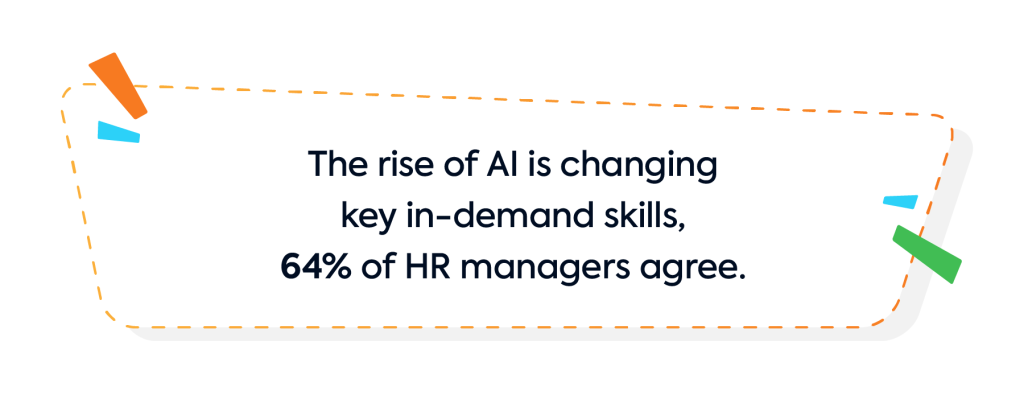
The top 3 in-demand cognitive skills in the AI era are
problem-solving, creativity, and the ability to learn.
Key takeaways
The rise of AI is changing key in-demand skills, 64% of surveyed HR managers agree.
43% of HR executives think their company will face a skills gap because of the rise of AI.
85% of HR managers plan some kind of L&D investment for training employees on AI.
Which skills are essential in the AI era?
Frontier tech is changing the landscape of capabilities and competencies that drive organizations and people forward. This new landscape is the main focus of the TalentLMS research, examined through the lens of the new in-demand skills.
The research centers around four skill clusters: digital, interpersonal, cognitive, and self-management skills. Aiming to examine universal skill sets that are broadly applicable, our research didn’t touch upon role-specific skills. Instead, it took a wider perspective, to uncover insights relevant to the workforce across the board.
In a nutshell, the figure below shows the 12 hard-hitting skills HR managers predict will be essential in the AI era.
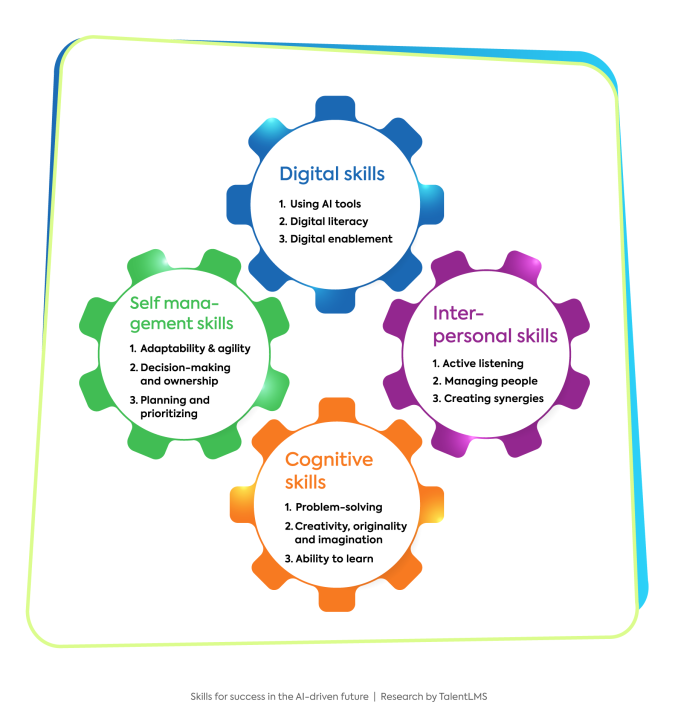
Digital Skills
Top-rated:
1) Using AI tools
2) Digital literacy
3) Digital enablement
Digital skills will be important in a new workplace shaped by AI and automation, 65% of surveyed HR managers think. And using AI tools is the top-ranked digital skill. This ability includes a wide spectrum of use cases, including navigation of AI-powered systems, familiarity with AI interfaces, and usage of game-changing, generative AI.
Proficiency in using AI tools is expected to unlock tremendous possibilities in lifting productivity and efficiency, driving innovation, refining the decision-making process, and much more.
Digital literacy and digital enablement, the first and the second runner-up digital skill, are intertwined but distinct, each contributing to a different aspect of digital transformation. Digital literacy involves manipulating computerized information and digital use tools, platforms, and systems. Digital enablement is about choosing the right technology so that a system, device, platform, or tool serves its purpose, and creating an environment where digital transformation can flourish. Both will be powerhouse abilities in the AI-infused future, supporting digital-first strategies and AI adoption.
Interpersonal Skills
Top-rated:
1) Active listening
2) Managing people
3) Creating synergies
Online and offline, we’re surrounded by constant chatter, instant reactions, and an endless stream of words and opinions. But talking loudly does not mask the lack of thoughtfulness and skills. Data from our research reflect this, as the key interpersonal skill voted by HR managers is the ability to listen.
Talking is just one aspect of communication, and yet it dominates the related conversation. The more subtle skill of listening often gets lost in the shuffle, despite its importance. Attentive listening builds bonds of understanding between people, leading to an environment of trust and respect, enriched with diverse viewpoints. An open mind and receptiveness are the building blocks of this skill, along with a focus on understanding people and situations before responding. Organizations that are developing this skill can benefit from it on multiple fronts, from having exceptional teamwork and smooth workflows, to building synergistic cultures and meaningful workplaces.
The runner-up on the list of interpersonal skills is managing people—an evergreen and sought-after people skill. Creating harmonious team environments with stellar performance requires a complex set of abilities that will be in high demand as AI takes hold.
Moving on, intertwined with active listening and managing people, the third top-rated people skill is creating synergies. This skill, which describes how well people work together, is foundational for synchronized, cohesive, and agile teams. Combined, these three interpersonal skills result in the ability to create a unified vision and common goals, break down silos, and bring people, teams, and stakeholders on the same page. And that will be a treasured set of competencies in an AI-fueled workplace.
65% of HR managers find that interpersonal skills will be important as AI and automation are becoming more prevalent in the workplace.
Cognitive Skills
Top rated:
1) Problem-solving
2) Creativity, originality, and imagination
3) Ability to learn
Every disruption that drives us forward creates a new set of challenges along the way. Artificial intelligence is not an exception, and its benefits go side-by-side with roadblocks. That may be one of the reasons why problem-solving is voted a key cognitive skill by surveyed HR leaders. As fast-evolving technology brings new complexity and challenges into the workplace, problem solvers who can design solutions and simplify this overwhelming complexity will be highly prized.
Problem-solving involves both analytical and creative thinking, with the latter being featured second on the list of cognitive skills prioritized by HR pros. Creativity, originality, and imagination encompass this very important cognitive skill, underscoring the value of nurturing potential across both hemispheres of the brain. The ability to learn rounds up the top-voted cognitive skills, unfolding the need for an agile and adaptive mindset. Science has found a connection between memory and imagination, pinning down that learning and brainstorming are intertwined in our brains.
65% of HR managers find that cognitive skills will be important as AI and automation are spreading in the workplace.
Self-management Skills
Top rated:
1) Adaptability and agility
2) Decision-making and ownership
3) Planning and prioritizing
From the early days of the human species to today’s high-tech civilization, what kept us alive and helped us thrive was the ability to adapt to new circumstances. This adjustment to an ever-changing environment, crucial to our survival and success, is a skill that stretches throughout millennia, remaining equally important. In our research, it unsurprisingly ranked at the top of the list of self-management skills.
The following top-voted skill reflects a need for finding a way through the overwhelming information overload of the high-tech era. The abundance of data makes it harder to come to conclusions and make decisions. Reaching clarity, direction, and accountability requires decision-making and ownership.
Planning and prioritizing are rounding the list of key self-management skills in the new world of work. Essential in translating decisions into actions, planning and prioritizing encompasses the ability to create a roadmap for reaching objectives and following through, while assessing options and changing the course when necessary.
As AI and automation are becoming more prevalent in the workplace, 60% of HR managers think that self-managing skills will be important.
Emerging skill alert: AI fluency as the new must-have skill
AI fluency has emerged from the data as a new, highly prioritized skill. Over half of HR managers think AI literacy is the new must-have skill for all employees, regardless of whether they work in technical or non-technical roles. This finding highlights the transformative impact of AI, and a pressing need to embrace it.
To stay relevant, employees need to equip themselves with AI literacy: the ability to understand, interact with, and leverage AI technologies effectively. This new skill can enable employees to remain competitive in the fast-evolving job market, adapt to changing work dynamics, and seize emerging roles that require AI integration. And employers will benefit from having AI-fluent employees, who can leverage new technologies to improve organizational results.
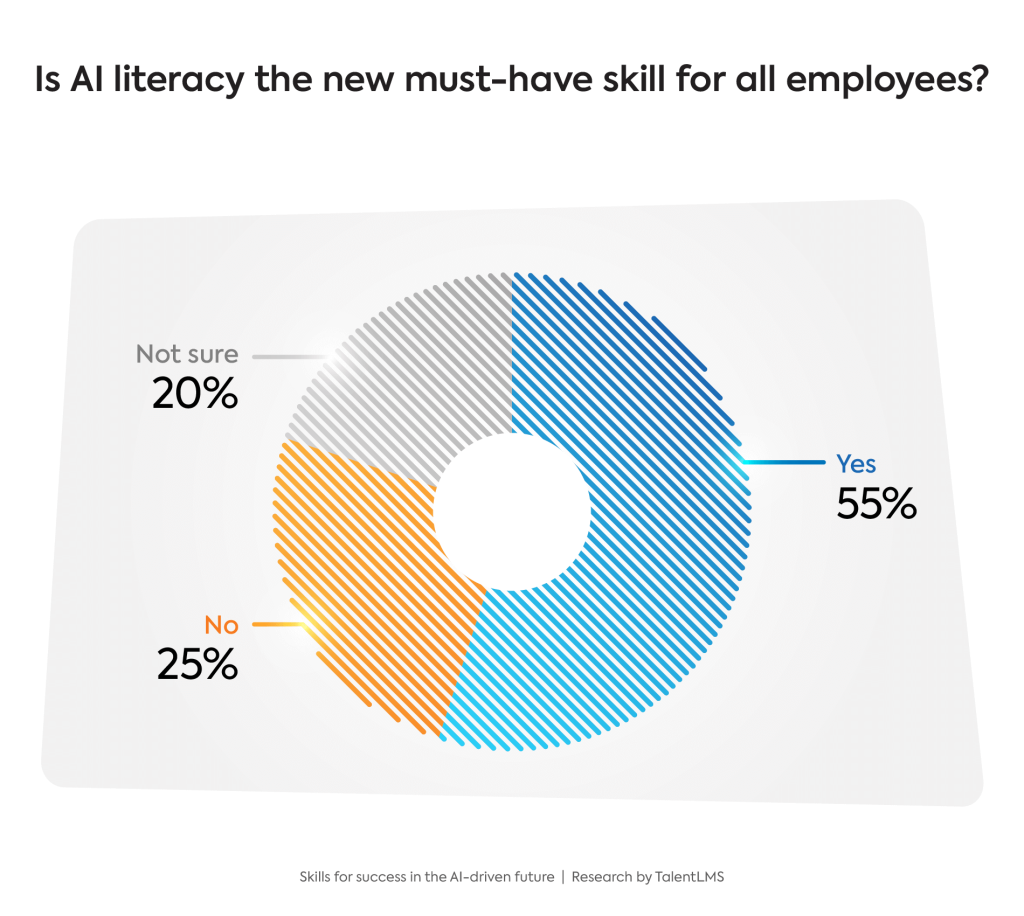
Soft Skills in focus: The oomph of human touch
Artificial intelligence is super slick in producing efficient results in the realm of hard skills.
It zips through repetitive tasks with ease, crunches data, assists in brainstorming, and answers multiple questions in a snap. But know-how from the realm of soft skills remains uniquely human, and the TalentLMS research unpacked that their prominence will grow.
Soft skills enable people to collaborate well, understand others’ points of view, adapt to changes, and build meaningful relationships. For forward-looking organizations, developing and refining soft skills among the workforce should be a priority.
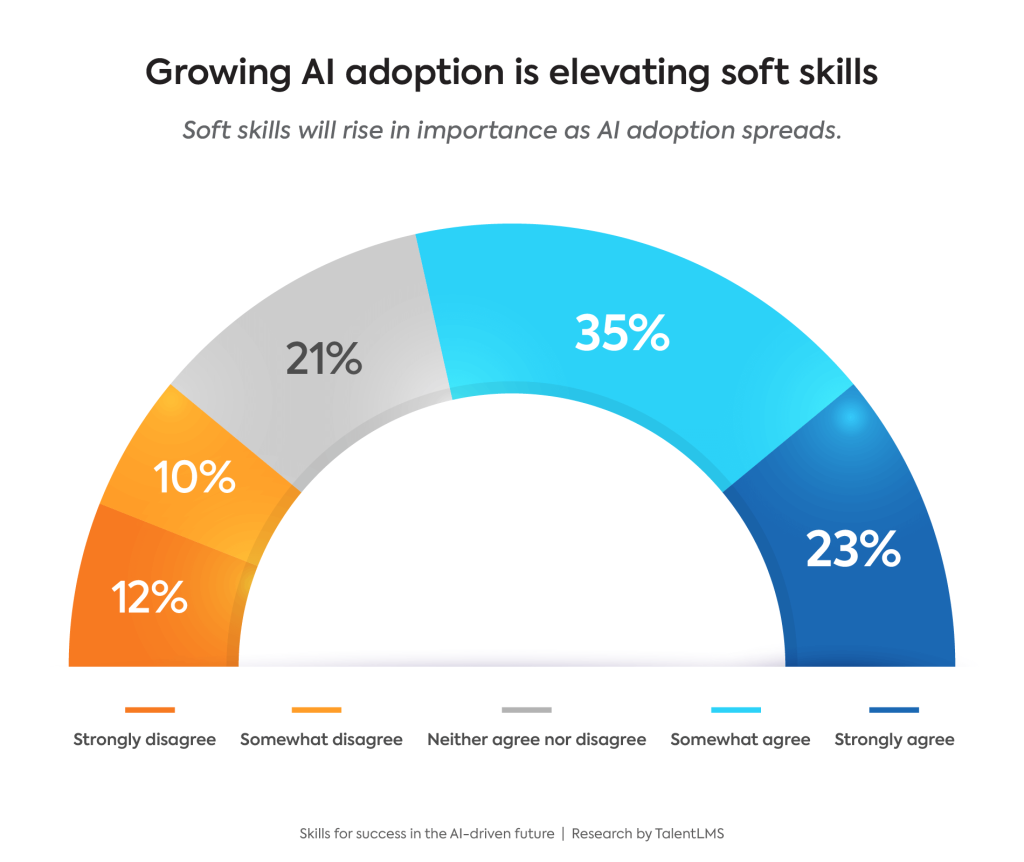
Prep your organization for the AI-driven future
Automate your training with TalentLMS.
Sign up in seconds, test the platform forever, upgrade whenever.
The looming skills gap: Assessing and overcoming the skills shortage
AI is accelerating the problem of missing competencies and skill shortages. The TalentLMS research confirms this, unveiling that 43% of surveyed HR managers think their company will face a skills gap because of the rise of AI.
Asserting the skills gap
The first step in overcoming the shortage is to measure it. Zooming into how companies tackle this assessment, research revealed that only 11% of HR managers are not measuring skills gaps in their companies.
The rest rely on different evaluation tools and systems, with performance reviews being the most common one; 46% of HR managers are using performance reviews for measuring a skills gap. Feedback from managers (36%) and skills gap analysis (34%) follow respectively. Finally, 30% of HR managers already use AI to measure skills gaps in their companies.
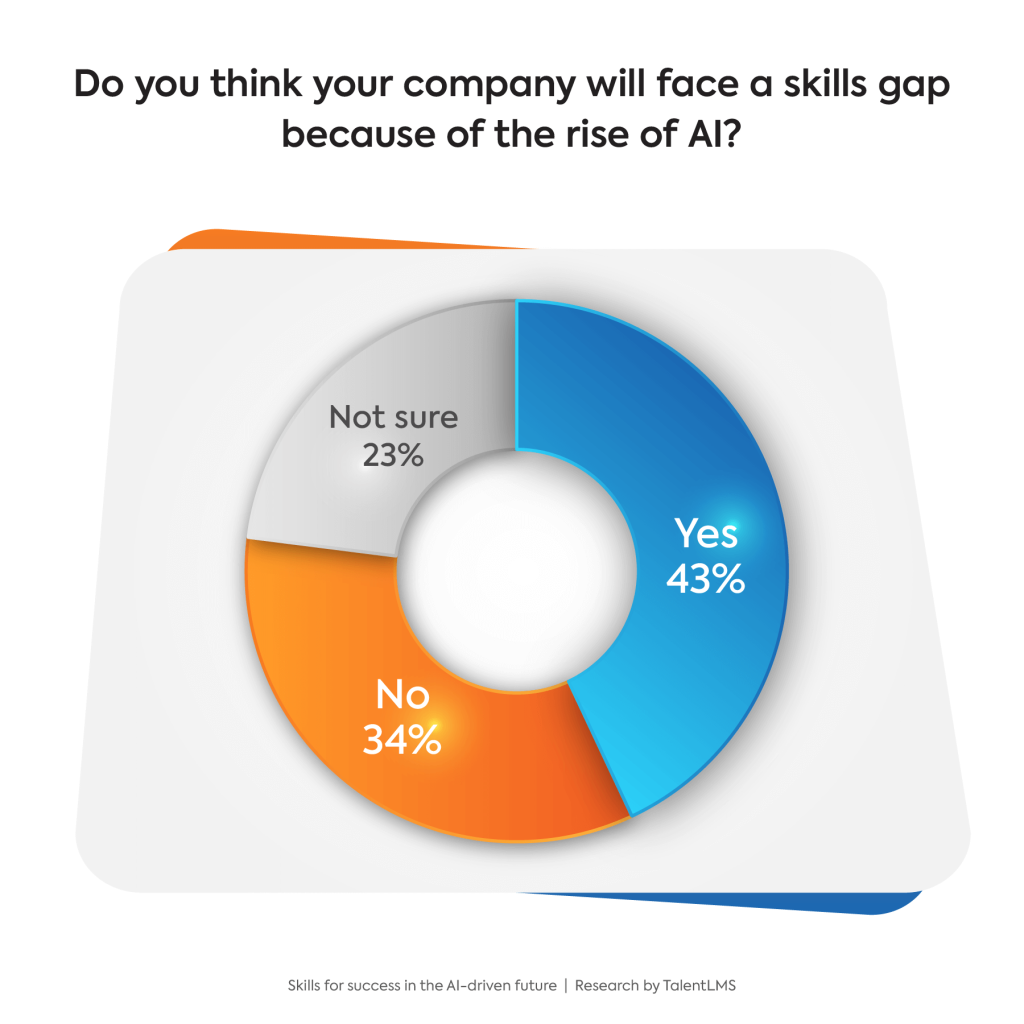
Overcoming the skills shortage
Now that we’ve seen the variety of ways companies use to gauge the skills shortage, let’s look at how they plan to overcome it. The following figure represents the responses of HR managers who said that they face a skills gap in their company.
Data showed that, for unlocking the missing skills, the majority of HR managers will use upskilling and reskilling initiatives, along with investing in AI training tools. Focusing on in-house talent, 35% plan to use internal mentoring and coaching to rise above the gap. Finally, while the majority plan to retrain the existing employees, over 4 in 10 will turn to hiring for covering the missing skill sets.
The data centered around the missing skills unveiled that the majority of HR managers is already trying to solve the issue, as only 9% of companies facing a skills gap don’t have a plan for overcoming it.
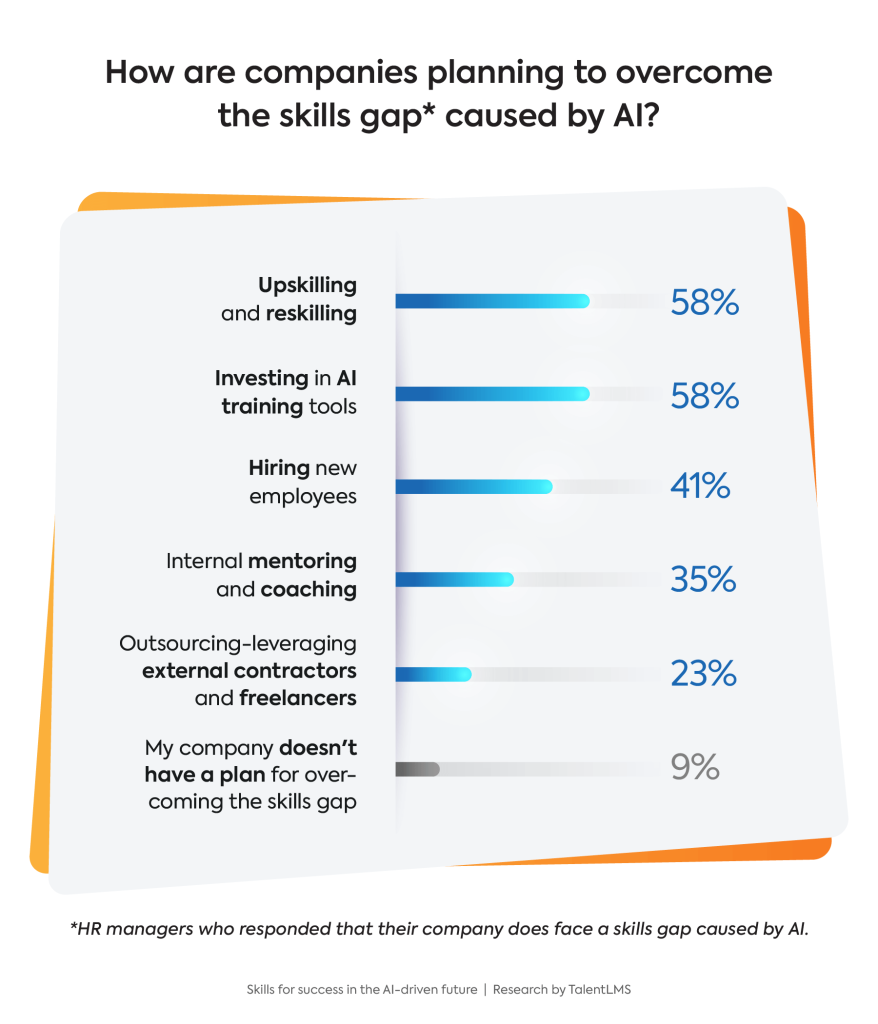
How is AI reshaping the workplace: Bold promises, daunting challenges
Generative AI has the potential to automate work activities that absorb 60 to 70 percent of employees’ time today. However, on the opposite side of this big promise of flawless precision and productivity, there are voices expressing ethical concerns and warning of rising dangers. Will AI manage to soothe concerns, overcome obstacles, and deliver on soaring expectations? That remains to be seen.
This dual sentiment is at odds with the TalentLMS research data. The overall view appears to be positive, although the data did reveal some mixed views on AI’s impact on the workplace.
Propelling the workplace
AI holds great promise when it comes to automating workflow, assisting with tasks, automatizing routine processes, and improving productivity and efficiency. In particular, 62% of HR managers agree that AI will help employees with repetitive tasks, allowing them to focus on more strategic and creative work. And the majority (57%) agree that upskilling employees for the AI-driven future will boost overall productivity. Through this lens, AI looks like a trusty sidekick at work.
When it comes to employers, it seems they’ll benefit widely from AI, using it to propel their companies into the future successfully: 64% of HR managers said that AI helps employers in navigating changes and preparing for a tech-driven future.
Employees caught between anxiety and urgency
On the other side of the AI coin, employees increasingly worry that AI will take over their jobs, and feel pressured to keep up. Specifically, AI-driven urgency to develop new skills is increasing employee stress, 56% of HR managers agreed. Additionally, 58% say AI is increasing job insecurity among employees. These findings are offering new insights into the negative side of AI adoption.
Generational AI gap
Further, AI impacts different generations varyingly, with 65% of HR pros foreseeing younger employees will shift to digital skills and roles, in order to adjust to the AI-driven future. Conversely, older generations will feel less confident at work compared to their younger coworkers because of AI, 58% of HR managers agree.
PC Mag’s research is at odds with these findings, highlighting that older workers worry more about the AI disruption, while younger employees are relatively excited to use AI at work.
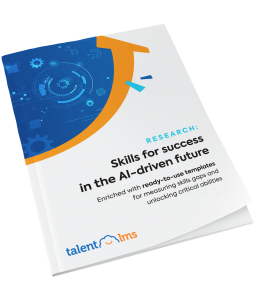
Download the full scale report
Gain a blueprint for navigating the growing complexity of an AI-infused workplace.
Unlock a framework for rating your employees in skills essential for a successful transition.
Rocking the AI future with L&D: Unlocking new skillsets, toolsets, and mindsets
Learning and development can play a key role in unlocking the potential and value of AI. Along with widening and updating the skills repertoire, L&D programs can guide employees in building new toolsets for streamlining tasks and responsibilities, making it possible to shift their focus from tasks to objectives and, from hands-on to tactical.
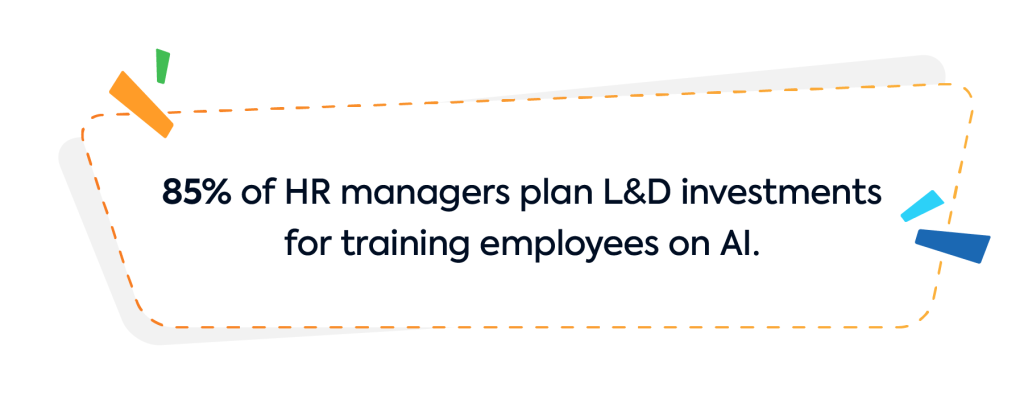
HR is recognizing these potentials, with the vast majority of surveyed HR managers (85%) planning some kind of L&D investment for training employees on AI. In the following section, we’ll dive deeper into where these investments will go.
L&D budget needs are on the rise because of AI
In light of AI adoption in the workplace, 54% of HR managers find that allocating a budget for AI training is important. As for where this budget is directed, the graph below shows which AI training investments are forthcoming. The data also uncovered a minority of 15% of respondents who are not planning any L&D investments.
Investing in online courses is the #1 priority, with close to half of HR managers planning to allocate a budget for them. Face-to-face training and live events (44%) are next, followed by workshops and webinars (40%). Moving on, 35% of HR execs plan to get an online platform to train employees on AI. Finally, 34% will invest in hiring external trainers, consultants, or subject matter experts, and 21% will rely on company-sponsored scholarships.
In the last section of the report, we’ll see that for a successful transition into the AI future, HR executives plan to double down on learning and development.
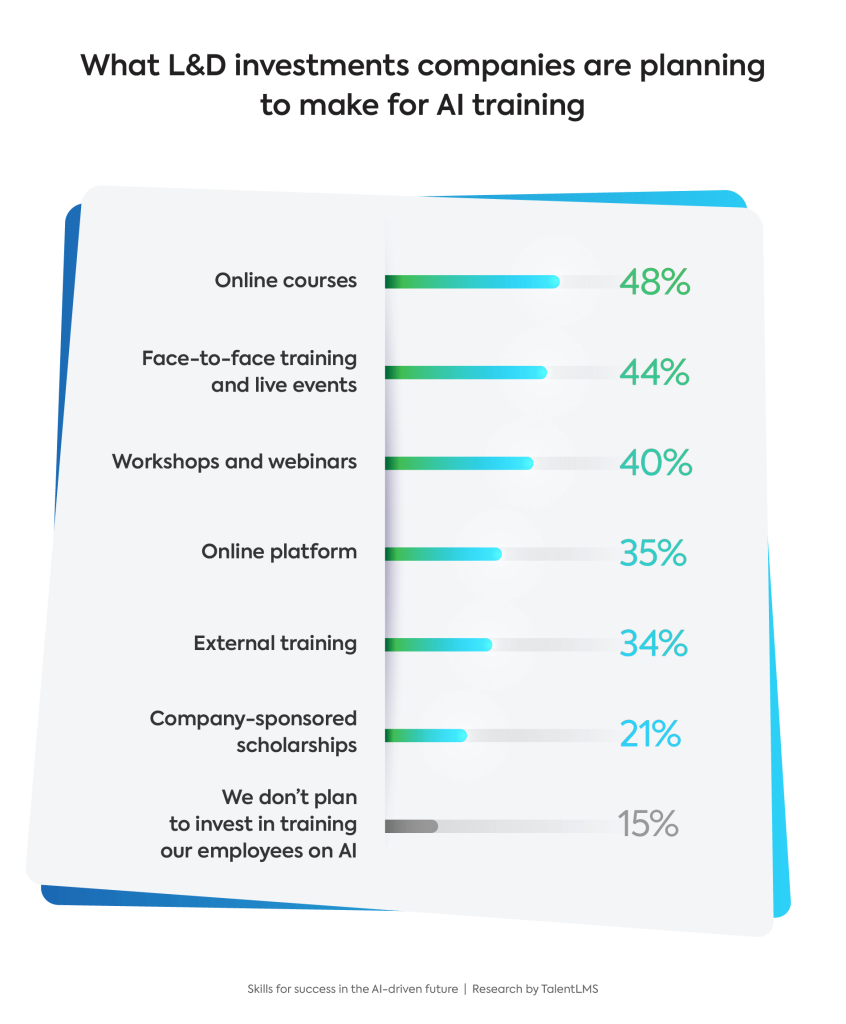
Upskilling and reskilling for easing the transition
Artificial intelligence and other frontier technologies are rapidly changing skill needs and occupational roles. To meet the new needs, organizations can roll out initiatives for developing new competencies across departments and teams, and deliver them through upskilling and reskilling.
Over 6 in 10 HR managers find upskilling and reskilling of employees important in light of AI adoption in the workplace, as seen in the figure above. Learning more advanced skills for the existing career path (upskilling), or developing new competencies for a different role (reskilling), can help employees respond to changing demands. What’s more, companies can leverage them for easing the transition of employees and supporting their adoption to the new world of work.
Retraining existing employees through upskilling and reskilling is a backbone of a successful L&D strategy, which drives organizations forward through an ongoing infusion of new skills into the workforce. Ongoing upskilling and reskilling helps organizations remain relevant and future-ready, with 63 % of HR managers agreeing that it has become critical because of AI.
How important are upskilling and reskilling in light of AI adoption?
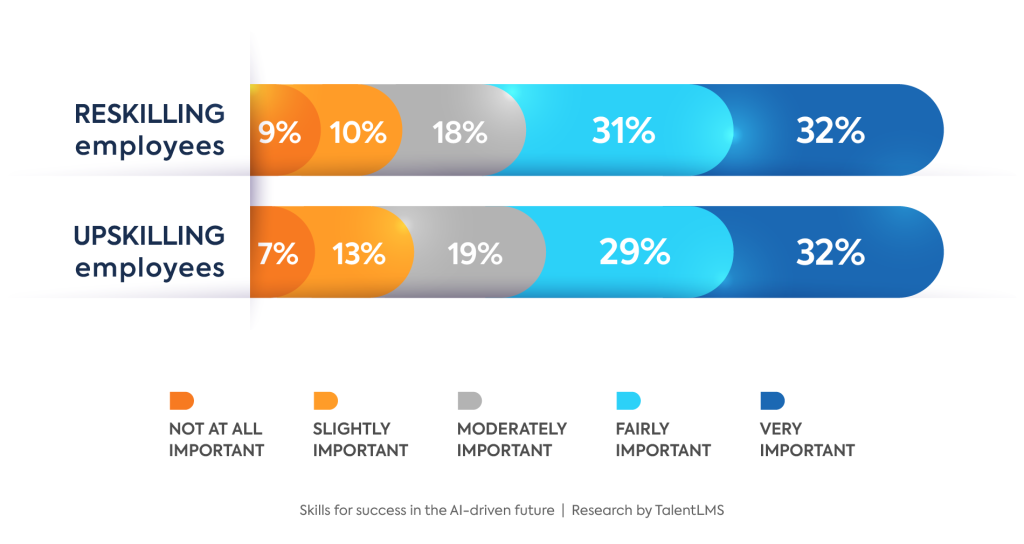
Implementing AI in training: Promising potential, lingering obstacles
While implementing AI in training is still in the early stages, AI’s capability to speed up and automate the creation of training content holds a great potential. However, despite the potential benefits, there are lingering issues to resolve before rampantly putting AI in use for creating learning content.
Let’s see what the surveyed HR managers think the main holdbacks are:
Regulation and data privacy tops the list, underlining a more general AI concern. How will different authorities react to growing concerns, and potential pressure for regulation, remains to be seen.
Accuracy of information in training content is the next obstacle, which likely has to do with generative AI, and cases of inaccurate responses and flawed content. Next, the respondents voted AI skepticism and AI phobia as a barrier to training—the latter defined as an exaggerated fear of artificial intelligence.
Finally, algorithmic bias—describing systematic and repeatable errors that create unfair outcomes, such as privileging one arbitrary group of users over others may also hinder the implementation of AI in workplace learning.
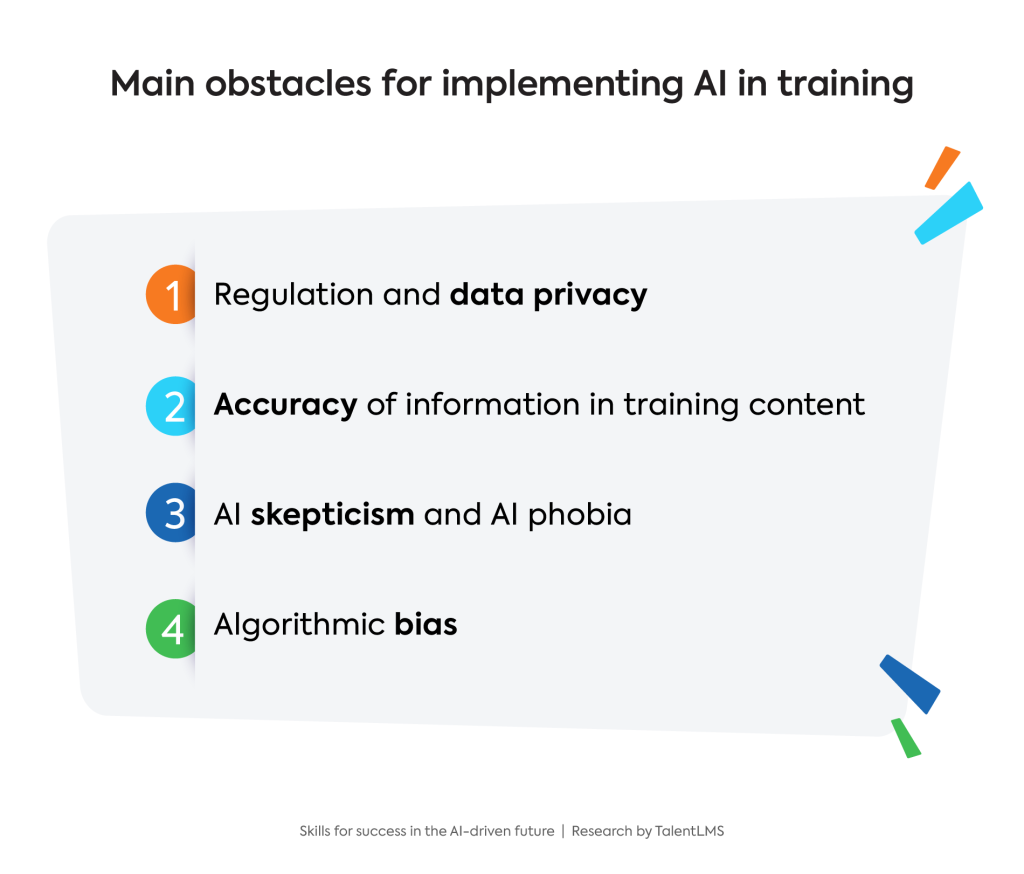
Training employees to use AI tools
The previous section explored the roadblocks on the way of implementing AI in training initiatives across the board. Now, when it comes to AI-specific training—educating employees on how to use AI tools—the majority of HR pros agree on its importance: 63% find it important to train employees on AI.
To meet this need, and help their workforce understand the new technology, employers can offer courses on learning about AI. Training employees on how to use AI will help them keep up with developments.
Blueprint for the successful transition into the AI-driven future
In prepping for the unknown future, organizations should remain agile and flexible. Old structures that worked in the pre-AI world may be challenged, as new practices emerge. With many variables still remaining unknown, the TalentLMS research garnered invaluable insights for a successful transition into the AI-powered future. The following section expands on research insights, transplanting them into actionable advice and strategies for organizations.
In prepping for the unknown future, organizations should remain agile and flexible. Old structures that worked in the pre-AI world may be challenged, as new practices emerge. With many variables still remaining unknown, the TalentLMS research garnered invaluable insights for a successful transition into the AI-powered future. The following section expands on research insights, transplanting them into actionable advice and strategies for organizations.
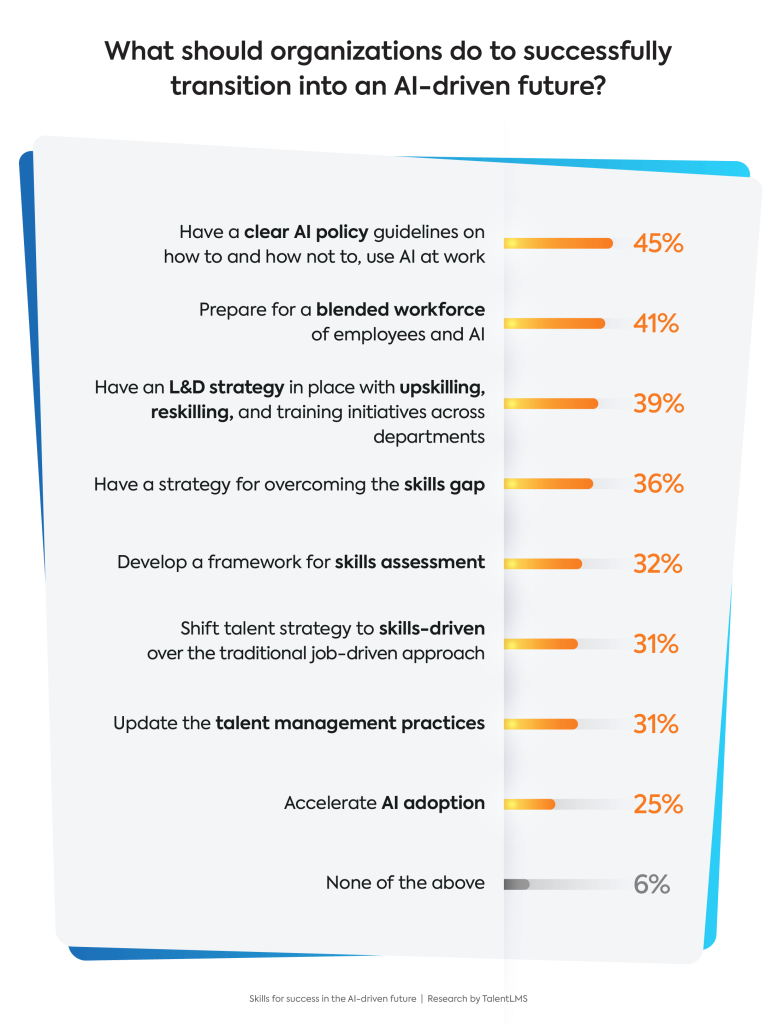
Setting the groundwork: Company-wide AI policy
Before enthusiastically jumping on the AI bandwagon, basic groundwork needs to be set on an organizational level. That starts with a clear AI policy. Organizations should be specific on how their employees should, and should not, use AI at work. This was the top pick on the list, whereas 45% of HR managers say companies should lay out a clear AI policy to successfully transition into an AI-driven future.
Preparing for a blended workforce of people and algorithms
The ability to learn, apply the acquired knowledge, and navigate complex data is no longer exclusive to humans. We have found a way to instill our intelligence into other systems, creating its artificial representation.
This resulted in intelligent algorithms spreading through various domains like wildfire, with generative AI being widely embraced and admired for its ability to provide seemingly unlimited knowledge on-demand, and in a snap. The upcoming challenge is integrating this digital brainpower with human capabilities successfully, creating a blended workforce of humans and algorithms.
Starting to work toward this integration might be a smart choice, with 41% of HR managers saying that companies should prepare for a blended workforce of employees and AI, to get ahead of the current transition.
Doubling down on L&D
Across the research, we’ve seen data on companies prioritizing L&D as AI takes hold. For over a third of HR managers, having a thorough L&D strategy with upskilling, reskilling, and training initiatives across departments is needed for a smooth shift into the AI-guided future. HR executives seem to plan to double down on learning and development, to equip the workforce with new, needed skills and competencies.
A contributing factor to prioritizing L&D may be the looming skills gap—which remains top of mind for HR pros, as 36% think that having a strategy for overcoming it is important, to succeed in adapting for the future.
Developing a framework for skills assessment
For upskilling and reskilling initiatives to hit the spot, companies should approach these strategically, and rely on data to make decisions. Along with defining which competency domains and skills the programs will target, developing a framework for gauging the level of existing proficiency is foundational. Close to a third of HR pros think this is an important step for successfully navigating the changes.
Since the workforce’s skill proficiency underpins the whole skill-building strategy, we included in the report ready-to-use templates to help training, L&D, and HR professionals develop their own assessment framework. The templates are designed to evaluate the competency level of the top-voted four skills, one from each skill cluster. You can find them in the last section of this report.
Updating talent strategy: Shift to a skills-driven approach
Organizations that adopt a skills-based approach are achieving better business results than those with job-based practices, according to Deloitte. They outperform in critical domains, such as retaining high performers, innovating, improving processes, and organizational agility.
Our research mirrors the notion that shifting talent strategy toward a skills-driven approach may be gaining more traction. Updating talent management practices, along with leaving behind the traditional job-driven approach, is considered important for around a third of surveyed HR executives. With frontier tech evolving rapidly and wrecking existing structures, a more flexible approach is needed. In the near future, we may be seeing more companies replacing job titles and requirements with clustered skill collections.
AI adoption as a competitive advantage
Finally, 1 in 4 HR pros said that, to successfully transition into an AI-driven future, companies should accelerate AI adoption. Once a company-wide AI policy is official, the next step in making the most from AI can be a playbook with various use cases and tools, showing how to use AI to optimize the workflow, ease the workload, and consequently improve results.
Now that AI technology and its immense possibilities are widely recognized, a race for adoption across domains has begun. The velocity of this adoption may provide a competitive advantage to the organizations that get there first.
Conclusion
Drawing from the top-voted skills from the examined skill clusters, here’s a portrayal of an invaluable employee for the AI-driven future: They are a person with an agile mindset, who listens more than they talk, and knows how to solve problems—while being highly proficient in the usage of AI tools. Nurturing such employee profiles from within your organization, and developing their potential, can be strategic leverage in the fast-changing environment.
Concluding, here’s a way to think about making the most out of AI in a business context: AI has tasks. People have goals and objectives. Leveraging AI in doing tasks that’ll enable people to focus on what really matters, can form a strategic alliance between organic and artificial intelligence. That alliance can release the hindered potential of employees, and propel organization-wide growth.
About the research
The survey was conducted online among 309 HR managers from different industries across the U.S. The survey ran from June 10 to June 19, 2023.
Company size of surveyed HR managers:
1-50: 77 | 51-250: 85 | 251-500: 39 | 501-1,000: 36 | 1,001-5,000: 36 | >5,000: 31 | Prefer not to say: 5
Gender breakdown: Female (62%), Male (38%)
Age groups breakdown: 18 – 24 (16%), 25 – 34 (31%), 35 – 44 (27%), 45 – 54 (15%), > 54 (11%)
About the research team
Ana Casic, Christina Pavlou and Giota Gavala from TalentLMS
Read more about AI’s impact on the workplace
Train your people. Measure results. Drive growth.
TalentLMS gives you the tools to supercharge every step of your training.


